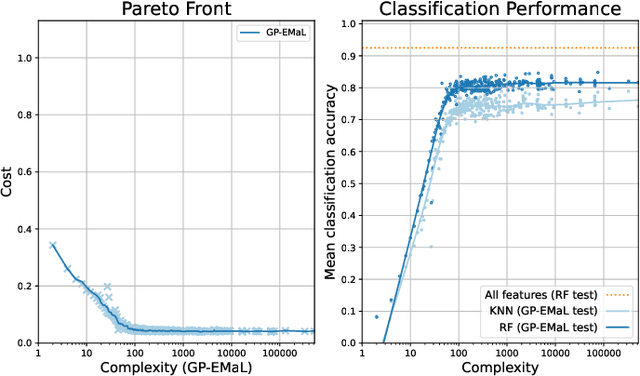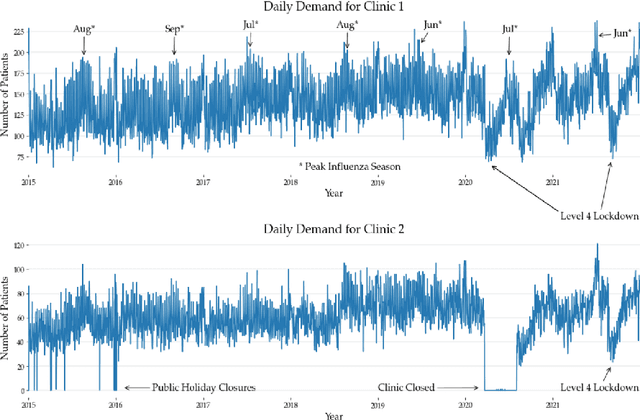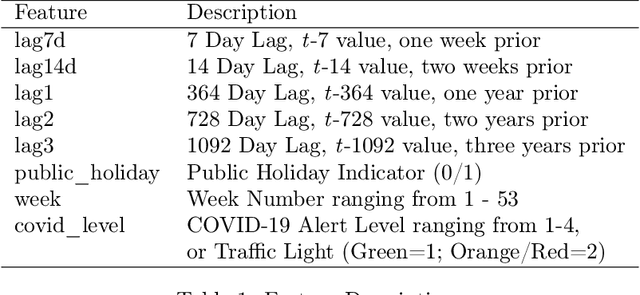Paula Maddigan
Genetic Programming for Explainable Manifold Learning
Mar 21, 2024



Abstract:Manifold learning techniques play a pivotal role in machine learning by revealing lower-dimensional embeddings within high-dimensional data, thus enhancing both the efficiency and interpretability of data analysis by transforming the data into a lower-dimensional representation. However, a notable challenge with current manifold learning methods is their lack of explicit functional mappings, crucial for explainability in many real-world applications. Genetic programming, known for its interpretable functional tree-based models, has emerged as a promising approach to address this challenge. Previous research leveraged multi-objective GP to balance manifold quality against embedding dimensionality, producing functional mappings across a range of embedding sizes. Yet, these mapping trees often became complex, hindering explainability. In response, in this paper, we introduce Genetic Programming for Explainable Manifold Learning (GP-EMaL), a novel approach that directly penalises tree complexity. Our new method is able to maintain high manifold quality while significantly enhancing explainability and also allows customisation of complexity measures, such as symmetry balancing, scaling, and node complexity, catering to diverse application needs. Our experimental analysis demonstrates that GP-EMaL is able to match the performance of the existing approach in most cases, while using simpler, smaller, and more interpretable tree structures. This advancement marks a significant step towards achieving interpretable manifold learning.
Explaining Genetic Programming Trees using Large Language Models
Mar 06, 2024



Abstract:Genetic programming (GP) has the potential to generate explainable results, especially when used for dimensionality reduction. In this research, we investigate the potential of leveraging eXplainable AI (XAI) and large language models (LLMs) like ChatGPT to improve the interpretability of GP-based non-linear dimensionality reduction. Our study introduces a novel XAI dashboard named GP4NLDR, the first approach to combine state-of-the-art GP with an LLM-powered chatbot to provide comprehensive, user-centred explanations. We showcase the system's ability to provide intuitive and insightful narratives on high-dimensional data reduction processes through case studies. Our study highlights the importance of prompt engineering in eliciting accurate and pertinent responses from LLMs. We also address important considerations around data privacy, hallucinatory outputs, and the rapid advancements in generative AI. Our findings demonstrate its potential in advancing the explainability of GP algorithms. This opens the door for future research into explaining GP models with LLMs.
Forecasting Patient Flows with Pandemic Induced Concept Drift using Explainable Machine Learning
Nov 01, 2022Abstract:Accurately forecasting patient arrivals at Urgent Care Clinics (UCCs) and Emergency Departments (EDs) is important for effective resourcing and patient care. However, correctly estimating patient flows is not straightforward since it depends on many drivers. The predictability of patient arrivals has recently been further complicated by the COVID-19 pandemic conditions and the resulting lockdowns. This study investigates how a suite of novel quasi-real-time variables like Google search terms, pedestrian traffic, the prevailing incidence levels of influenza, as well as the COVID-19 Alert Level indicators can both generally improve the forecasting models of patient flows and effectively adapt the models to the unfolding disruptions of pandemic conditions. This research also uniquely contributes to the body of work in this domain by employing tools from the eXplainable AI field to investigate more deeply the internal mechanics of the models than has previously been done. The Voting ensemble-based method combining machine learning and statistical techniques was the most reliable in our experiments. Our study showed that the prevailing COVID-19 Alert Level feature together with Google search terms and pedestrian traffic were effective at producing generalisable forecasts. The implications of this study are that proxy variables can effectively augment standard autoregressive features to ensure accurate forecasting of patient flows. The experiments showed that the proposed features are potentially effective model inputs for preserving forecast accuracies in the event of future pandemic outbreaks.
Forecasting Patient Demand at Urgent Care Clinics using Machine Learning
May 25, 2022



Abstract:Urgent care clinics and emergency departments around the world periodically suffer from extended wait times beyond patient expectations due to inadequate staffing levels. These delays have been linked with adverse clinical outcomes. Previous research into forecasting demand this domain has mostly used a collection of statistical techniques, with machine learning approaches only now beginning to emerge in recent literature. The forecasting problem for this domain is difficult and has also been complicated by the COVID-19 pandemic which has introduced an additional complexity to this estimation due to typical demand patterns being disrupted. This study explores the ability of machine learning methods to generate accurate patient presentations at two large urgent care clinics located in Auckland, New Zealand. A number of machine learning algorithms were explored in order to determine the most effective technique for this problem domain, with the task of making forecasts of daily patient demand three months in advance. The study also performed an in-depth analysis into the model behaviour in respect to the exploration of which features are most effective at predicting demand and which features are capable of adaptation to the volatility caused by the COVID-19 pandemic lockdowns. The results showed that ensemble-based methods delivered the most accurate and consistent solutions on average, generating improvements in the range of 23%-27% over the existing in-house methods for estimating the daily demand.
 Add to Chrome
Add to Chrome Add to Firefox
Add to Firefox Add to Edge
Add to Edge